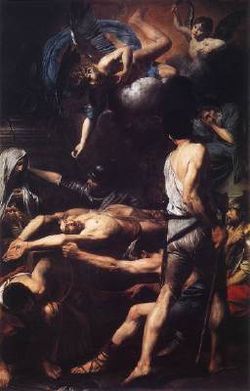- Martinian and Processus
-
Saints Processus and Martinian 
The Martyrdom of Martinian and Processus. Valentin de Boulogne. 1629.Martyrs Born c. 3rd century Died c. 303
RomeHonored in Roman Catholic Church; Eastern Orthodox Church Major shrine St. Peter's Basilica, Rome Feast 2 July Saints Martinian and Processus or Saints Processus and Martinian (Italian: Martiniano and Processo) were Christian martyrs of ancient Rome. The dates of these martyrs are unknown, as well as the circumstances of their deaths.
Contents
Burial
The Martyrologium Hieronymianum (ed. G. B. de Rossi-L. Duchesne, 85) gives their names under July 2. The Berne manuscript of the Martyrology also gives their burial-place, viz. at the second milestone of the Via Aurelia, or at the catacombs of St. Agatha on the Via Aurelia. The old catalogues of the burial places of the Roman martyrs likewise mention the graves of both these saints on this road (De Rossi, "Roma sotterranea", I, 182-3). Other sources state simply that they were buried in the cemetery of Damasus.
Legend
One legend makes them imperial soldiers assigned as the warders of Saint Peter and Saint Paul in the Mamertine Prison (Richard Lipsius, Apokryphe Apostelgeschichten und Apostellegenden, II, Brunswick, 1887, 92, 105 sqq., 110 sq.). It cannot be shown how the legend came to give them this identification.
The legend states that they were converted and baptized by Peter after a spring flowed miraculously in the prison, and the two wardens were baptized in the miraculous waters. They were martyred along with Paul after being arrested and tortured. They were beheaded by order of the emperor Nero. After their martyrdom, a woman called Lucina is said to have buried them in her own cemetery.
In fact, as the Bollandist Hippolyte Delehaye and the Roman Martyrology[1] state, they were buried in some unknown year in the Cemetery of Damasus at the second milestone of the Via Aurelia.
Veneration
They were publicly venerated in Rome from the fourth or perhaps the third century. They were buried in the cemetery of Damasus. In the fourth century a church was built over their tomb. At this church, Saint Gregory the Great preached a homily on their feast day, "in which he referred to the presence of their bodies, to the cures of the sick, to the harassment of perjurers, and the cure of demoniacs there."[2] This church no longer exists. They are mentioned by Bede, and their feast was thus known to have been celebrated in early medieval England.
Pope Paschal I (817-24) translated the bones of the two martyrs to a chapel in the old Basilica of St. Peter. They still rest under the altar dedicated to them in the right (south) transept of the present St. Peter's Basilica. Their relics, originating in their apostolic era cemetery along the Via Aurelia, after being moved to various other locations, were placed in 1605 in a porphyry urn under the altar at St. Peter's, which is flanked by two antique yellow columns. The hemisphere has three roundels with scenes from the life of St. Paul.
Their feast is celebrated on 2 July. "All that is known about these martyrs, apart from their names, is that they were buried in the Cemetery of Damasus on the Via Aurelia on 2 July."[3] Their feast was removed in 1969 from the Roman Catholic calendar of saints wherever the Roman Rite is in use, but they continue to be mentioned in the Roman Martyrology, the official list of saints recognized by the Roman Catholic Church.[1] Pre-1969 calendars grant these saints only a Commemoration within the Mass of the Visitation of Our Lady; but according to the rules in the present Roman Missal,[4] they may be celebrated everywhere with their own Mass on their feast day, unless in some locality an obligatory celebration is assigned to that day.
References
- ^ a b "Martyrologium Romanum" (Libreria Editrice Vaticana, 2001 ISBN 88-209-7210-7)
- ^ David Hugh Farmer, "The Oxford Dictionary of Saints" (Oxford: Clarendon Press, 1978), 337
- ^ "Calendarium Romanum" (Libreria Editrice Vaticana, 1969), p. 128
- ^ General Instruction of the Roman Missal, 355 c
Sources
- David Hugh Farmer, "The Oxford Dictionary of Saints," Oxford: Clarendon Press, 1978, p. 337.
External links
- (English) Catholic Encyclopedia: Sts. Processus and Martinian
- (English) Catholic Online: Sts. Processus and Martinian
- (English) Serbian Orthodox Church: Sts. Processus and Martinian
- (English) Martyrdom of St Processus and St Martinian (1629), by Valentin de Boulogne
- (English) The Altar of Saints Processus and Martinian
 This article incorporates text from a publication now in the public domain: Herbermann, Charles, ed (1913). Catholic Encyclopedia. Robert Appleton Company.Categories:
This article incorporates text from a publication now in the public domain: Herbermann, Charles, ed (1913). Catholic Encyclopedia. Robert Appleton Company.Categories:- Christian martyrs of the Roman era
- 1st-century Christian martyr saints
Wikimedia Foundation. 2010.
